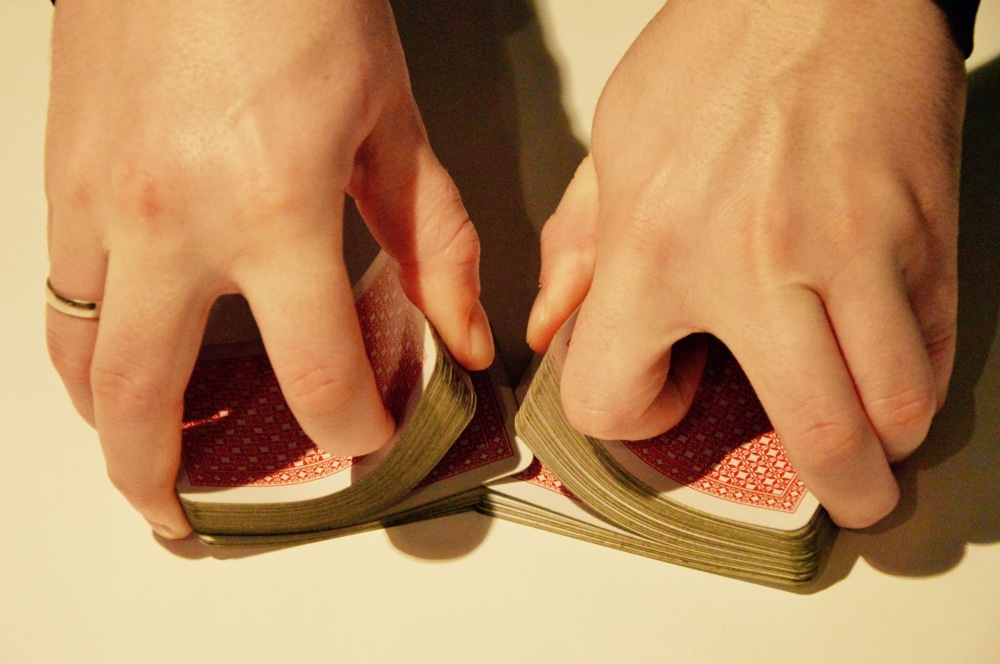Usually, variations of traditional card games are created by companies that sell them commercially. However, there are games created for the commercial market by professional or amateur game creators, such as Phase 10. Here are the rules and how to play the Phase 10 card game.
Phase 10 History
The commercial card game Phase 10 was created by Kenneth Johnson and was based on a game called Contract Rummy he and his brother played as children. However, it wasn’t until he was laid off from his job as an auto worker in the early 1980s that he took time to create the game.
The company Fundex Games was able to get the rights to distribute the game in 1987. The negotiations took place over a cold glass of milk and a “Grand Slam” breakfast. The department store Kmart sold Phase 10 for almost 30 years.
Phase 10 Card Game Rules
The object of Phase 10 is for the players to complete all 10 phases of the game. The game is challenging, and each phase increases in difficulty.
As you complete each phase, you can go to the next one, but if you get stuck on a phase, you must remain on it until you can solve it. The winner is the first one to solve all 10 phases, but if there is a tie, the player with the lowest score wins.
Dealing the Cards
A dealer is chosen amongst the players and then shuffles the deck. They distribute the cards to each player, one at a time face down. The players hold their cards in their hands so the others cannot see them.
The remaining cards are put face down in the middle of the table, called the draw pile. The dealer takes the first card from the draw pile and places it face-up next to it, which then becomes the discard pile.
Play begins when the player to the left of the dealer takes a card from either the discard or draw pile and puts it in their hand. They then place a card from their hand on top of the discard pile to end their turn.
What are the Phases?
Each player tries to complete phases, each of which is a combination of cards. The combinations are runs, sets, cards of all one color, or a combination of runs and sets. The 10 phases are:
- Two sets of three cards.
- One set of three and one run of four cards.
- One set of four and one run of four.
- One run of seven cards.
- One run of eight.
- One run of nine.
- Two sets of four cards.
- Seven cards of one color.
- One set of five and one set of two.
- One set of five and one set of three.
Players can only make one phase during their turn.
Definitions of Phase 10 Plays
Sets: A set is two or more cards of the same number. So, a set of three cards would be three fives or three sevens. If you needed two sets of three, they could be all the same card, such as three sevens and another set of three sevens. The sets can be a combination of colors.
Runs: If you need a run, then you need four or more cards in numbered order. For instance, a run would consist of a two, three, four, and five. They can be any combination of colors.
All of One Color: If you need cards of all one color, you can use red cards, green cards, or yellow, etc. The cards come in green, red, blue, and yellow. The cards do not need to be sequential.
There are both “Wild” and “Skip” cards in a deck for the Phase 10 card game. The wild card can be used in place of a numbered card or card color to complete a set. So, if you have a run of two, three, four, the wild card can complete the run by using it as a five. If you need a set of sevens and only have two, the wild card can become the third one.
More than one wild card can be used to complete a phase, but one of the cards in the phase needs to be natural. Players cannot replace wild cards with natural cards once they’ve been played. If the dealer turns over a wild card, the first player can pick it up and put it in their hand to complete a phase.
The only use for a skip card is to make a player lose a turn. If a skip card is in the discard pile, it cannot be picked up, but a player may draw a skip card from the draw pile and use it or put it in their hand. If they use it, then they name the player who will lose a turn.
Only one skip per player can be used per round. If the dealer turns over a skip card, the first player is skipped.
How to Play Phase 10 Card Game
When the dealer finishes giving the players their cards, the first player can pick up the card on the discard pile, unless it is a skip card. Then, they can try to complete the first phase, or any phase they are on in subsequent turns.
Making Phases
If they complete the first phase, their turn is over, and the player to their left takes their turn. The players take their turns in clockwise order, always the one to the left.
When a phase is completed, it must be laid down face-up on the table. However, the phase should be complete before laying it down.
Players can lay down more than the minimum number of cards for sets and runs if the additional cards can be directly added to the phase. Once a player completes a phase and lays down their cards, they need to discard one.
Hitting
Once you’ve made a phase, you can try hitting to get rid of leftover cards. A hit consists of putting cards from your hand on a phase that’s already on the board. The cards must fit into the phase before you put it down. For instance, if you have a set consisting of three fours for phase two, then you can add another four to the set.
Wild cards can be used as color or numerical cards to add to cards of all the same color, sets, or runs. Before you can hit, you must lay your complete phase down, and once you do, you can hit on your phases or another player’s.
Finishing Hands
Once you complete a phase, in order, you can lay down your cards during your turn. If you use all your cards, you “finish your hand,” or “go out.” The player who goes out first wins the hand, but other players can complete a phase if possible. Those players who complete a phase move onto the next one.
Players who have leftover cards total their scores. The fewer cards you have left, the better. The next dealer than shuffles the cards and deals them to begin the next hand.
Scoring the Game
Each player should keep a running tally as each hand concludes. The winner of a hand will get zero points. The leftover cards scores are:
- Numerical cards one through nine equal five points.
- Cards 10 to 12 score 10 points each.
- Skip cards are 15 points.
- Wild cards are 25 points.
Only the cards left in a player’s hand are scored, not the ones they’ve already laid down.
The winner of the overall game is the first one who completes the tenth phase of the game. If more than one player has completed it, then the one with the lowest score wins. However, if there is a tie, then the 10th phase is replayed, and the winner of the hand is the winner of the game.
Phase 10 Masters Edition Card Game
One of the variations of the Phase 10 card game is the masters’ edition. It is played much like the original version, except for the addition of two rules:
1) During their turn, a player can choose which phase to complete after viewing their hand. This change should help speed up the game and eliminate runaway leaders.
2) Players can also save one card per hand, instead of needing to discard one. So, they can bank cards they may need for later phases or bank wild and skip cards. This rule is another attempt to speed up the game.
In addition to the rules, there are four sets of phase cards to help remind players which phase they have chosen. The masters’ edition of the game is limited to four players, but the original game can have up to six players.
If you and your friends want to learn a fun, challenging new card game, buy a deck and try Phase 10.

